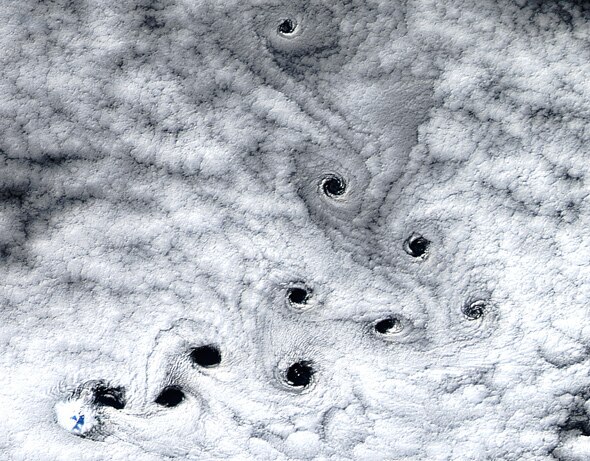Create a free profile to get unlimited access to exclusive videos, sweepstakes, and more!
Kinked Vortices

Wow! What a great example of von Kármán vortices!
This image, taken by Landsat 8 on May 3, 2016, shows a layer of stratocumulus clouds over the southern Indian Ocean. Poking above the layer is Mawson peak, a stratovolcano (lots of stratos in this shot) on Heard Island, one of a chain of volcanic islands near Antarctica.
The wind is blowing to the east near the island, which creates a wiggling tail of air downstream from the island as it flows around. As that tail “flaps”, the vortices are spawned, which then flow along with the wind. As I’ve written before:
Imagine you have a cylinder (a pencil, or a bucket, or a concrete pylon) that you place in flowing water. It’s an obstacle, and the water will flow around it.
However, near the cylinder’s surface the water slows, piling up a bit. The water farther from the cylinder is moving faster. This causes eddies (vortices) to form, curls in the water. This kind of motion is a bit unstable, and can cause a slight force, pushing the water perpendicular to the direction of flow. But the water all around the flow pushes back, causing a sort of oscillation, like a pendulum swinging. The result is a series of vortices forming and flowing downstream, one on each side of the obstruction, alternating in pattern.
An animation, in this case, is worth way more than a thousand words:
See how the fluid wiggles like a tadpole tail downstream? Eventually those vortices dissipate, losing coherence due to turbulence and drag. This process from start to finish is called “vortex shedding”, which just sounds intrinsically cool.
I love stuff like this, but what makes this even more fun is that in the Landsat 8 image, you can see the winds take an abrupt left turn, suddenly blowing north. That’s not easy to see in the clouds themselves, but it’s pretty obvious when you look at the chain of vortices, which make a sudden change in direction.
I found this picture (via @NASAEarth) on NASA’s terrific Earth Observatory Image of the Day site, one of my favorite places on the ‘net. They also mention that you can use the NASA WorldView page to zoom in and out of this shot, putting in in the greater context of flows around the southern continent. Amazing.
If you’re a US citizen, your tax dollars have already paid for all this, so go play. And if you’re not American, please allow us to let you use this for free. If I may speak for NASA, it’s honestly our pleasure to share our wonderful planet with you.














